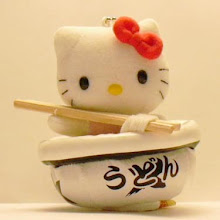Another Kitty Inspired Purchase
 I've been waiting for Gotochi/Asunaro to come out with a limited promotional line of Kitties for the summer - you know something to do with the fireworks and/or Obon season. Looks like they won't be doing anything and frankly, I'm more than a tad disappointed with their recent offerings interms of limited promotional items. It all looks rather...run-of-the-mill; something that Sanrio could have done on their own. Oh well.
I've been waiting for Gotochi/Asunaro to come out with a limited promotional line of Kitties for the summer - you know something to do with the fireworks and/or Obon season. Looks like they won't be doing anything and frankly, I'm more than a tad disappointed with their recent offerings interms of limited promotional items. It all looks rather...run-of-the-mill; something that Sanrio could have done on their own. Oh well.
Since there won't be any fun summer limited mascots for this year, I decided to re-use an old plush to introduce yet another item that this Kitty line inspired me to learn about, track down and experience for myself. This particular item is one that neither myself or my parents knew of despite its traditional roots. How we managed to live without it will forever remain one of those wonderful Kitty mysteries.
KATORI BUTA

In this 2003 Senko Hanabi version, Kitty not only displays traditional fireworks-viewing garb, she also carries the ubiquitous Katori Senko: a convenient holder for the classic Japanese mosquito repellent. It's a simple, functional item, but it works amazingly well!

What is it? Honestly, I had no idea what this item was and the only time I had seen it was with this particular Kitty line. I assumed it was a kind of small firecracker that kids might use. Boy, was I wrong.
It turns out that this strange, ceramic, pig-shaped item is a nifty little holder for mosquito coils. Instead of having a plain old coil burn away on a plate or can lid, the pig houses the coil and diffuses its steady smoke stream through its eyes, large nose and out its...ham - okay, its butt. It's also portable, which makes it even better.

My new outdoor muse, the traditional Katori Buta. A nice pair to "traditonal" blogging with pen and paper.
Growing up, my dad burned Raid mosquito coils at our summer house in Maine. He used the simple aluminum metal stand that came in the package and he'd put it on a small plate to catch the ashes. It was a sight and smell that was forever anchored to my father and to those wonderful nights in Penobscot Bay. As the years went by, Raid started making "improvements" to their coils which eventually led to us no longer using them. They tried to cover up the scent of the coil with something more "floral" and they replaced the metal stand with a plastic ring and some wire. The new improved smell was overwhelming and the new and improved stands were unstable and did not lend itself well to anything smaller than a full coil. As I look back, I'd have to say the decline of the Raid mosquito coil seemed to coincide with the decline of those magical summers. The property we rented each summer was getting sold-off piece by piece to the toffs trying to escape the Hamptons and frankly, we were all getting older and more cynical. Digging clams with your hands is pretty cool when your 5 years old, but when you're an obnoxious teenager, it's decidedly uncool.

The usual 50 piece box or 30 piece cannister with fancy insulated stand for burning coils
My Dad eventually asked his sister to send the Japanese mosquito coils or katori senko. Sometimes she'd send the big 50 packs and other times she'd send the pretty metal cannisters that included a burning stand in the lid. Othertimes, she'd try to get my Dad to try the latest mosquito repellents that used small cartridges with pleasantly mild soapy scents. He was convinced they didn't work. On top of it, I think we all kind of missed the smell and the sight of coil's smoke snaking up to the sky.
Funny, in all those years, a Katori Buta never showed up....
From the little I've gleaned off the internet, the Katori Buta has a long and distinguished history with fighting mosquitos (it even has a cameo appearance in "My Neighbor Totoro"!) Originally, cedar needles and wood chips were burned inside the ceramic pig in hopes of turning away the nasty little blighters. We had actually tried local cedar incense ourselves since not everyone in the family was wild about the sometimes choking smoke of the katori senko. However, it still didn't work as well as the katori senko.

...it looks as if it wants to say something...
When I found these pigs on eBay, I purchased two - one for myself and one for my Mom. My Dad passed away back in March so it makes me a little sad to think that I couldn't share this funny but functional item with him. He absolutely HATED mosquitoes and I think he would have had a good laugh from this as well as appreciate its usefulness. I know my mom is enjoying it as she moves about her garden - the site of many viscious mosquito attacks. Mine stays by my side when I'm out on the linae drinking coffee with my Hubby and Kitties. I watch the smoke rise from the Katori Buta and I think of those summers in Maine and, of course, of my father. No doubt had he seen it, there would have been a Buta for every room in the house.
















